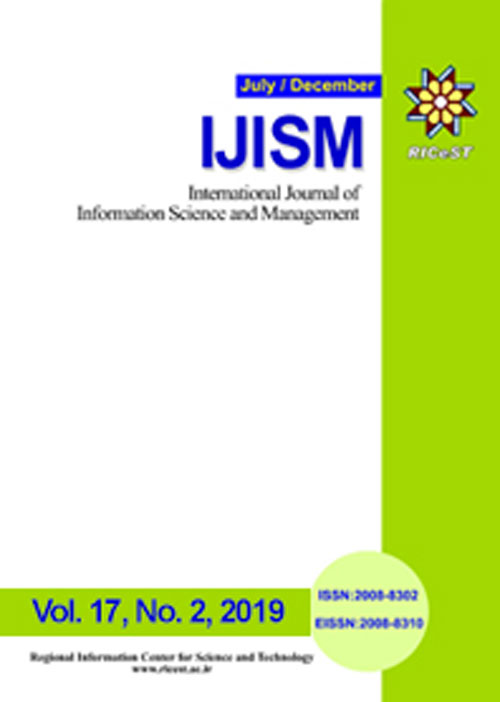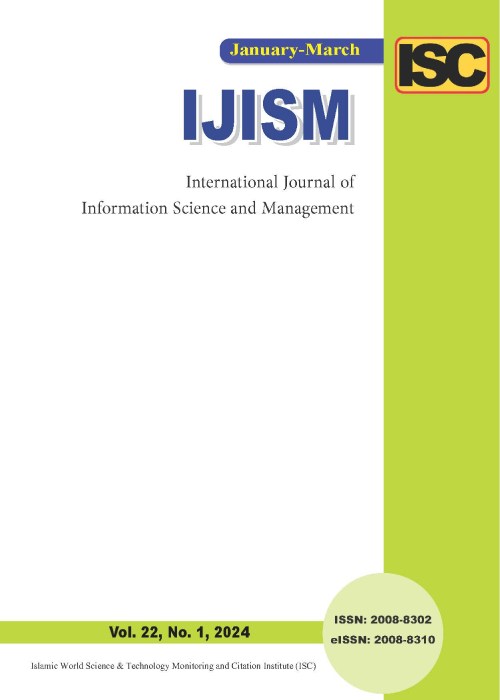فهرست مطالب

International Journal of Information Science and Management
Volume:17 Issue: 2, Jul-Dec 2019
- تاریخ انتشار: 1398/05/15
- تعداد عناوین: 8
-
-
Pages 1-18The research aims to study the status of Iran in the sub-index of innovation as the main indicator of the knowledge economy and to assess the interactions of the university, industry and government in the research and innovation system of the country. This research takes advantage of the World Bank Knowledge Assessment Methodology (KAM) framework to measure the sub-index of innovation and Triple-Helix model to investigate the relationship between university, industry and government in one of the variables of the innovation system. For that purpose, the World Bank's formula for Knowledge Economy Index was employed to measure the sub-index of innovation in Iran's economy from 1996 to 2016. The results of the computation of the innovation sub-index indicate a stable growth in that area for Iran. Subsequently, the Triple-Helix model was used to evaluate the university, industry, and government interactions, illustrating a small contribution of the industrial sector in the country's research areas. The study showed that despite the growth of the innovation index, the interactions of the innovation system components are not desirable and require targeted investment and focused planning strategy.Keywords: University, Industry, Government, Triple-Helix Model, Knowledge Economy, Innovation
-
Pages 19-31Co-citation forms a relational document network. Co-citation-based measures are found to be effective in retrieving relevant documents. However, they are far from ideal and need further enhancements. Co-opinion concept was proposed and tested in previous research and found to be effective in retrieving relevant documents. The present study endeavors to explore the correlation between opinion (dis)similarity measures and the traditional co-citation-based ones including Citation Proximity Index (CPI), co-citedness and co-citation context similarity. The results show significant, though weak to medium, correlations between the variables. The correlations are direct for co-opinion measure, while being inverse for the opinion distance. Accordingly, the two groups of measures are revealed to represent some similar aspects of the document relation. Moreover, the weakness of the correlations implies that there are different dimensions represented by the two groupsKeywords: Opinion, Co-opinion, Co-citation, Correlation, Citation Proximity Index, Similarity
-
Pages 33-53
The present research aims to represent the terms and concepts of civil engineering and thus design its domain structure in the form of ontology. This is an applied research and the qualitative content analysis method with summative approach is used. The research population is 12309 published articles in the scientific journals (1983 to 2016), indexed in the full-text Persian articles database at Regional Information Center for Science and Technology (RICeST). Data collection was done via SQL queries from the RICeST database. The content analysis was used to create a conceptual model of the civil engineering domain and to explain the relationships and instances. To create the conceptual model, there were consulted with 10 Subject experts in civil engineering area. The process of ontology creation has been done through METHONTOLOGY methodology and protégé ontology management software (Beta 5 edition). The made-artifact of this research has 283 concepts, along with 62 object properties, 79 data type properties, 10 annotative properties, and 976 instances. In total, in the present research, 151 semantic properties were identified between the concepts. The results of this research can serve as a guide for the RICeST experts in order to identify the users’ needs and facilitate the users’ interaction with RICeST databases. This can also provide the users with access to more relevant resources. This ontology can also be served as a layer of semantic web in these databases.
Keywords: Ontology, Civil Engineering Ontology, Regional Information Center for Science, Technology, RICeST Databases, Persian Articles, CivilOnto -
Pages 55-70Self-efficacy and the use of electronic information services acceptance among the university students can affect the learners' online services. This is the due to the learners' acceptance of using technology and its role in their life. Therefore, the complexity of online and offline services needs to be examined by the experts to assess the learners'' satisfaction which helps them to achieve electronic services. Learners' self-efficacy management can be evaluated as an important issue in the present study. The present study aims at investigating the survey of the relationship between the internet self-efficacy and using the electronic information services among the university students of Dezful Islamic Azad University, Khuzestan, Iran. The present study was conducted through descriptive-analytical method and took a correlational approach. The study sample included 387 students. Smart Partial Least Squares (PLS) was applied to investigate the study conceptual model. The results indicated that the use of the internet among the university students significantly affected the electronic services application (β =0.182). The same significant effects were also found in the variables including web specific self-efficacy on the acceptability of use (β=0.285), perceived control on electronic services application (β=0.142), perceived control on the acceptability of use (β=0.139), interpersonal norms on the acceptability of use (β=0.376), attitudes on the acceptability of use (β=0.169),perceived usefulness on attitudes(β=0.224), perceived amusement on the attitudes(β=0.335), perceived risk on the attitude (β=0.187), and internet self-efficacy on the web-specific self-efficacy(β=0.672). However, it was also made clear that the effects of web-specific self-efficacy on the electronic services application (β=0.033), social norms on the acceptability of use (β=0.061), internet self-efficacy on attitudes (β=0.079) and social norms on attitudes (β=0.026) are not statistically significant. The universities can prepare and compile appropriate training programs to take effective steps in the acceptability of the internet use that is in line with making students more informed and aware of the electronic services.Keywords: Electronic Information Services, Internet Self-efficacy, Islamic Azad University of Dezful, Perceived Risk, Perceived Usefulness
-
Pages 71-83For a sustainable development and greater success, digital libraries need to be evaluated at different time points. Usability study is a type of digital library evaluation.The aim of this study is identifying the usability of digital libraries in Tehran's public universities i.e. Sharif, Amirkabir and Tehran universities. Evaluative Survey methodology was used for the survey applying measures of search, navigation, forms layout, contrast and scan ability, optimization, help, usage of windows and speed and errors through a questionnaire containing 36 questions. The research population included 124,800 undergraduate, Master and PhD students, from three governmental universities of Sharif, Amirkabir and Tehran. Stratified random sampling method was applied to select 378 students as a sample which are 130 people in Tehran, Amirkabir 125 people and Sharif 123 people. For data analysis, SPSS software was used along with descriptive techniques as well as independent test and ANOVA where needed.The findings indicated that the criteria relating to the usability of digital libraries in the three Tehran governmental universities evaluated to be in relatively good condition and there is no significant difference between the digital libraries for the usability criteria. The results of this study suggest that according to the usability of digital library design creates more willingly resort to this type of user to visit the library and the realization of the objectives of the parent organization provides.Keywords: Evaluation, Usability, Digital library, Public Universities, Sharif University of Technology, Amirkabir University of Technology, University of Tehran
-
Pages 85-97Infopreneurship is the art of entrepreneurship using information and helps infopreneurs to struggle and stand in an arena called fair (bazaar) and make benefits with once they succeed. Hence, this research was conducted with the aim of providing a model for online Infopreneurship in Iran. The present research is an applied one in terms of its purpose, and carried out through quantitative approach and analytical survey method. The statistical population of this study included1835 directors and experts of websites and online businesses across Iran. Sampling was done randomly in through stratified simply class and 320 people were selected using Krejcie and Morgan table. The data collection instrument was a researcher-made questionnaire. Data were analyzed using one-group T-test, Pearson correlation coefficient, analysis of variance and factor analysis.The findings of this study showed that structural, behavioral, field, strategic, and consequential factors are correlated with the correlation coefficient of 0.74, 0.73, 0.75, 0.68 and 0.18 with the variables of Infopreneurship, and were significant at p <0.05. The high middle or high level online business companies include these factors. Eventually, a model of Infopreneurship was represented in relation to online businesses in Iran.Based on the suggested model, it can be concluded that the more the online information businesses in Iran enjoy the identified factors, the more the amount of infopruneurship and its consequences will be, and that such a model can be used as a comprehensive road map for individuals, organizations and online information businesses interested in infopruneurship in IranKeywords: Infopreneurship, Information Entrepreneurship, Online Businesses, Information, Iran
-
Pages 99-117The aim of this study was mapping, visualizing and determining subject trends in the field of information retrieval using author co-citation network based on articles indexed in Scopus from 2005- 2018. This scientometric study was performed using co-citation analysis. Research population includes all articles indexed in Scopus in the field of information retrieval from 2005 to 2018. Therefore, 35018 papers were retrieved in this field. VOSviewer was used to analyze the author co-citation. The study indicated that a total of 604757 authors were co-cited, 212328 journals were cited. Also highly cited articles and sources were determined. Amongst countries, United States, China, United Kingdom, Germany and Canada ranked one to five, respectively. Computer science was a pioneer with regard to interdisciplinary area in IR. It is noteworthy that visualization of author co-citation in field of IR determined ten clusters, namely knowledge and information science, computer science, electronics, information retrieval, information seeking behavior, psychology, multimedia information retrieval, software engineering, ophthalmology and surgery.Keywords: Information Retrieval, Author Co-citation Analysis, Research Trends
-
Pages 119-134The present study deals with ambiguity at word level focusing on homographs. In different languages, homographs may cause ambiguity in text processing. In Persian, the number of homographs is high due to its orthographic structure as well as its complex derivational and inflectional morphology. In this study, a broad list of homographs was extracted from some Persian corpora first. The list indicates that the number of homographs in Persian corpora is high and homographs with high frequency are those that occur as a result of the identical orthographic representation of some inflectional and derivational morphemes. Based on the list, the most frequent homographs are nouns and adjectives ending in <ی> /i/. POS tag disambiguation of such homographs would make word sense disambiguation easier and lead to better text processing. In this study, a list of noun and adjective homographs ending in <ی> is extracted in order to decide their correct POS tag. The result was studied to extract context-sensitive rules for allocating the right POS tag to the homograph in syntactic structures. The accuracy of rules was checked, and the result showed that the accuracy of most rules is high which proves most rules are true.Keywords: Homographs, POS tagging, POS Disambiguation, Noun, Adjective Homographs Context-sensitive Rules


